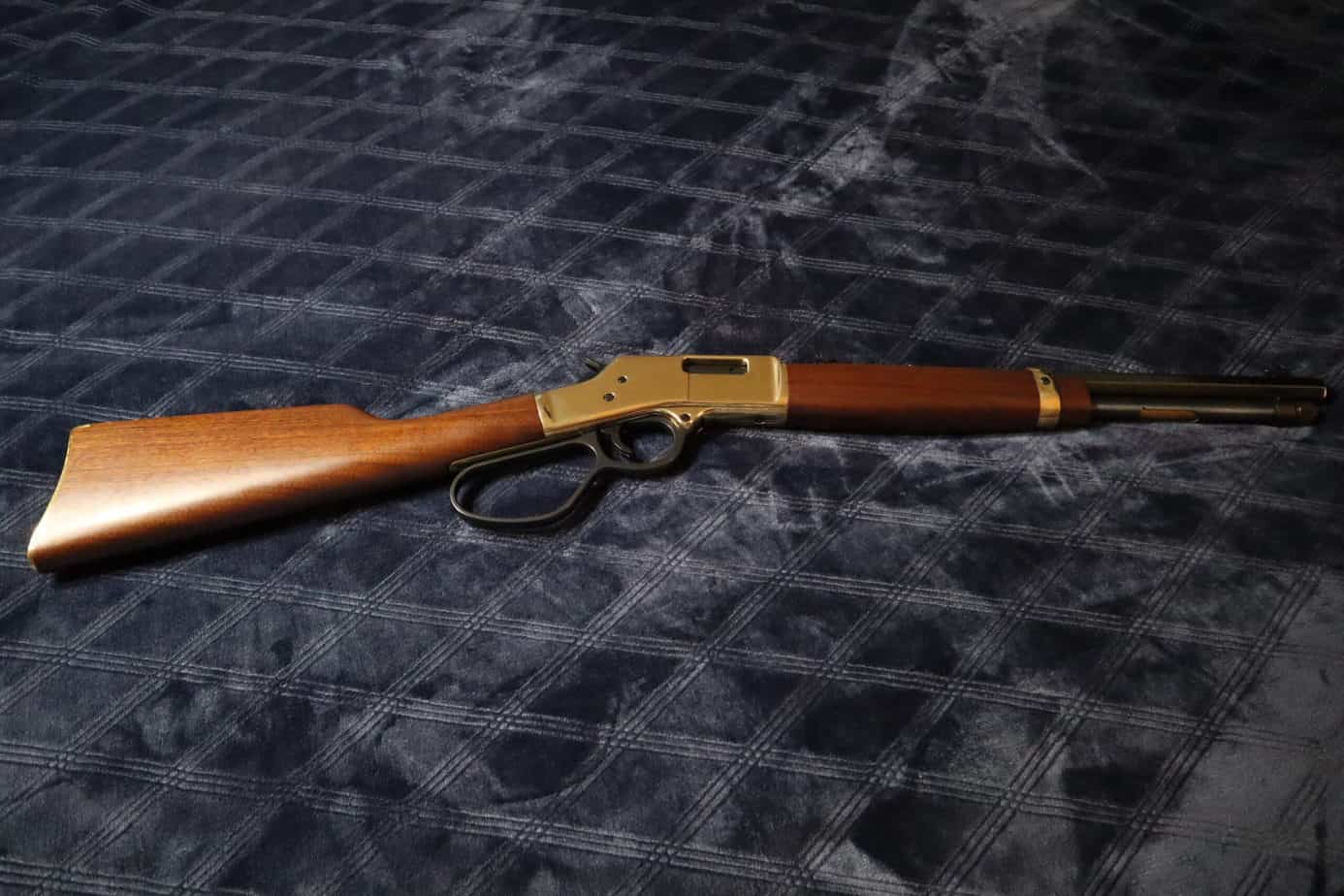I decided to check out the different types of rifles available. My husband’s collection includes semi-automatics like the AR-15, bolt action rifles like the Ruger American Predator, and lever action rifles like the Henry Lever Action.
A lever action rifle is loaded by pulling a lever to open the action and eject the last cartridge used. You then push the lever back into place, seating the next round. You must repeat this action with each shot.
The lever is located around the trigger guard. It may have a side loading gate under the ejection port or a feed tube where you drop the cartridges in one at a time.
Selective fire rifles can be burst action, semi-automatic, or fully automatic, also known as machine guns. These are heavily regulated and heavily taxed.
To feel the difference between the types of rifles for myself, I shot the Henry Lever Action and the Ruger American Predator bolt action.
Today we examine the lever action rifle.
HISTORY OF LEVER ACTION
A lever action revolver was patented in Italy in 1829. Colt produced the first lever action rifle in America in 1837. It had a cylinder like a revolver, and the ring at the front of the trigger would rotate the cylinder to the next position and cock the internal hammer.
The Spencer repeating rifle, produced between 1860 and 1869, was a magazine-fed lever-activated rifle chambered in .56-56 Spencer rimfire cartridges.
The lever had to be cocked to remove the used case and feed a new cartridge into the chamber, and then the hammer had to be cocked manually for each shot. It had a removable seven-round tube magazine in the buttstock.
The Henry repeating rifle was invented in 1860 by Benjamin Tyler Henry, an employee of Oliver Winchester. It had a centrally located hammer that was cocked by the rearward movement of the bolt.
It placed the magazine under the barrel rather than in the buttstock. Marlin introduced a repeating rifle in 1881. Marlin and Winchester released new models in 1894. The Marlin has a single stage lever action, whereas the Winchester has a double stage lever action.
Savage Arms introduced hammerless models in 1895 and 1899. The rotary magazine introduced by Savage allowed pointed bullets rather than requiring round or flat nosed bullets, for better aerodynamics to stabilize the path of the trajectory.
This makes pointed bullets travel farther. The expense of the rotary magazine eventually caused its replacement by a detachable box magazine.
Repeating shotguns have been manufactured with lever action as well, but were eventually replaced by slide action shotguns.
There was even a machine gun with an automatic lever action, the M1895 Colt-Browning machine gun, nicknamed the “potato digger” because the automatic lever action could dig into the ground if improperly seated on its mount. For more on the history of the lever action rifle, go to this Wikipedia article.
SPECS FOR THE HENRY
A few months back I shot the Henry Lever Action Carbine chambered in .38 special/.357 magnum for the first time. At 7.76 pounds it was surprisingly heavy for its 35 inch overall length and had very little kickback.
Carbine refers to the length of the barrel. Shorter than the standard rifle length, the carbine length rifle is lighter and more portable. It has a 16.5″ Octagon barrel in blued steel with the receiver finished in polished hardened brass.
The rear sight is a fully adjustable semi-buckhorn with diamond insert. Buckhorn refers to the shape of the appendages that stick up off the top of the gun. They remind me of football goalposts.
You line up the brass beaded front sight between the goalposts and center the target in your view just beyond the front sight.
It comes drilled and tapped for a scope but we do not have a scope on ours. The stock is made of American walnut and the buttplate is brass.
The Henry has a 14″ length of pull. The length of pull is the distance from the trigger to your shoulder when you have the butt of the gun resting against your shoulder.
At 4:07 in the video you can see the amount of bend in my elbow for a 14″ length of pull. At 5’2″ I have short arms, so my six foot husband will have a much more bent elbow with this gun.
My 10-year-old daughter finds the length of pull comfortable with the Henry, which is her favorite gun to shoot.
The Henry has no external safety, meaning that you cannot push a switch to make it nonfireable. The internal safety is a transfer bar.
The transfer bar safety works by adding a step to the process. Instead of the hammer directly acting on a loaded cartridge, the transfer bar activates the cartridge when it moves into place by the action of your finger on the trigger.
Until you pull the trigger, the transfer bar is out of alignment with the hammer. This gun has a very light trigger pull, around four pounds of pressure, which gives me an opportunity to state one of the cardinal rules of gun safety: Keep your finger off the trigger until you are ready to shoot.
Henry recommends this type of gun for target shooting, hunting, and collecting. The large loop lever is a decorative effect that gives the gun its distinctive appearance. It also gives you more room to maneuver if you shoot wearing gloves. See more models at henryusa.com.
HOW IT WORKS
Most lever action rifles load through a side gate directly underneath the ejection port. You push the bullets into the side gate one at a time to load the feed tube. The follower is internal on the side loading rifles.
All Henry rifles have the feed tube that loads at the end of the barrel, but some new models also have a side loading gate.
The advantage of the side loading gate is that you don’t have to drop the bullets down into the end of the feed tube.
To unload the side loading gate, you must cycle the action by pulling the lever to unload each cartridge. The advantage of the Henry feed tube is the ease of unloading. You don’t have to cycle the action to unload live rounds.
To load an older Henry lever action rifle like the one I shot, you rotate the follower and lift it out of the feed tube. This makes room to load seven rounds in the feed tube one by one. Return the follower into the feed tube and rotate it until it locks in place.
Looking at the picture on the top of this article, you will see a familiar-looking trigger guard setup on the underside of the gun, plus a really big loop attached to the back of the trigger guard.
The lever action rifle works by pulling down this lever, which opens the action to eject the last cartridge used. You then push the lever back into place, seating the next round. You must repeat this action with each shot.
For the Youtube video we went to the rifle range and used a shooting bench on a raised platform. That allowed me to balance the Henry on a shooting stand, which made it much easier.
When I shot it at the pistol range I had to balance the weight of the gun myself, which required more concentration and made the operation less stable.
At pistol range distance, about 10 yards, I was a good shot. The bullets stayed in the first three rings of the target.
The rifle range has much longer distances, and the bullets I shot in the video sailed right past the target. This is because of the different angles involved in shooting from a platform three feet off the ground with a target two feet off the ground as well as the longer distance.
Oddly enough I was on target the same day with the bolt action rifle I shot for the same video. The difference may have been the scope on the bolt action rifle.
THE EXPERIENCE
The Henry was not at all noisy. Eye and ear protection is always a must for shooting, but the difference between the lever action and the bolt action is noticeably less startling. This is why my 10-year-old really enjoys shooting the lever action rifle.
Despite the serious stopping power of the .357 or .38 Special ammunition used in this rifle, the kickback was barely noticeable. Holding the butt of the rifle against your shoulder dampens the blow when the speeding bullet rushing out the front of the rifle causes a backward motion at the back of the gun.
I had to learn to click the lever firmly into place each time just like you have to make sure the door to your car is fully in place every time you get in. The car will drive with the door ajar, but the rifle will not chamber the next round until the lever is snugly in contact with the underside of the stock.
As a left-handed person in a right-handed world, I try to learn to do everything with both hands, including shooting. Self defense instructors advocate learning to shoot with either hand to give you more options when the moment of necessity is upon you, but I do it more as a personal challenge.
As you can see in the Youtube video, I did have to adjust the position of the rifle against my shoulder when I switched sides, and the gun rest had to be moved because of the different angle.
The Henry is ambidextrous because the loading takes place at center rather than on the right or left. The disadvantage to switching back and forth is that I fumbled quite a bit as I had to adjust mentally to the function of the shooting hand versus the support hand with the motions involving in operating the lever between shot.
Using a lever action rifle is not difficult once you have figured out what you are doing.


